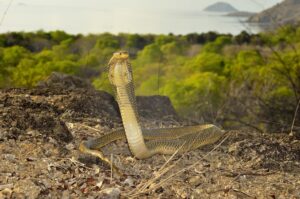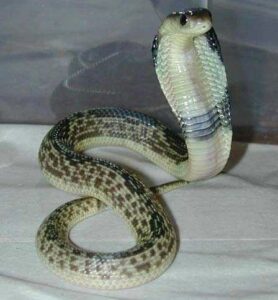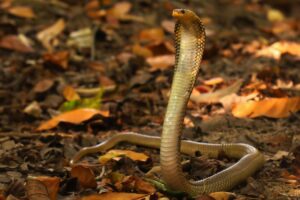The Javan spitting cobra is a member of the elapid family. It is also called the Indonesian cobra or the Komodo spitting cobra. In 1827, German herpetologist Friedrich Boie first described this species. Their genus name ‘naja‘ derives from the Latinized Sanskrit word nāgá meaning “snake”. And the species epithet ‘sputatrix‘ is derived from the Latin word sputator, meaning “spitter”.
These snakes are highly terrestrial and show nocturnal behavior.
Scientific Classifications
- Suborder:Serpentes
- Family:Elapidae
- Genus:Naja
- Species:N.sputatrix
Conservation Status
Description
Size
The average Javan spitting cobra can reach 4-6 ft (1-2 m) and weigh about 4 lbs (1.8kg).
Color and Appearance
They have elliptical heads slightly distinct from their necks with long cervical ribs that expand to form hoods when threatened. Javan spitting cobras also have moderate-sized eyes with round pupils, as well as short and round snouts with large nostrils. These snakes have black, brown, or yellow medium-large heavy bodies compressed in the dorsoventral and sub-cylindrical posterior.
The smooth dorsal scales are strongly oblique, and the scale count is typically 25-19. Different colors and patterns may occur between specimens depending on their range.
Juveniles can have band marks or spots on their throat. This species might not always have a mark on its hood, but when it does, the mark usually appears as a V-shaped pattern.
Are they Dangerous
This snake is a highly defensive species, readily spitting out venom when they feel threatened. The vitro anticoagulant activity of their venom is much stronger than most cobras. It has an LD50 value of 0.9 mg/kg, with essential components being enzymes and high-molecular-weight proteins, phospholipase A2 enzymes, polypeptide cardiotoxins, and postsynaptic neurotoxins; even though the venom is potent, it does not act as rapidly.
Although the fatality rate of this snake bite is low, one should not provoke venomous snakes like this.
A study investigating the conflict between humans and snakes in the Greater Jakarta Metropolitan Area was conducted in 2019. It reported a total of 656 snake encounters were reported among those Javan spitting cobra had 31% of encounters, making this species one of the most common snakes in that region.
Javan Spitting Cobra At a Glance
Distribution
These snakes are natives of Indonesian islands. Their distribution ranges across the Lesser Sunda Islands of Alor, Bali, Flores, Java, Komodo, Lomblen, Lombok, and Sumbawa. On 26 December 2015, a single specimen was spotted on Rinca Island.
According to a study by Indonesian herpetologist Frank Bambang Yuwono in 1998, the Javan spitting cobras were found in large numbers in Java. It had been reported in a study (Dunn 1927b) that specimens found on Komodo were at an elevation 2,130 ft from the sea level, which was the highest altitude for these cobras to be found.
Habitat
While this cobra can adapt to a wide range of habitats, they mainly inhabit tropical and wet forests. They are also found in arid regions, cultivated hill country, and dry woodlands. On Komodo Island, they live in deciduous monsoon forests and dry savannas.
Lifespan
Their exact lifespan remains unknown, though one can assume they live up to 20 years like other spitting cobras.
Predators
Komodo dragons prey on them very easily.
Diet
Their primary diet consists of small mammals like mice and rats, but they also consume frogs, lizards, and other snakes.
In a study by Herpetologist Shine Boeadi in 1998, 80 Javan cobra specimens from Java Island were anatomized and measured, which led to the finding that these snakes mostly prey on mammals.
Reproduction
The breeding season starts in August and ends in October, lasting through the entire dry season. Females lay a clutch of 13-19 eggs, with 16 being the average. The eggs are laid either at the end of the dry season or during early monsoon.
After incubating for 88 days, hatchlings emerge from the eggs. Like other species in the elapid family, they are independent from birth.
Similar Species
Equatorial Spitting Cobra
The equatorial cobra, Naja sumatrana, also called the black spitting cobra, is a terrestrial species native to equatorial Southeast Asian nations, with sightings in Brunei, Indonesia, Malaysia, Singapore, Thailand, and the Philippines.
Indo-Chinese Spitting Cobra
The Indo-Chinese spitting cobra, Naja siamensis, also called Siamese spitting cobra or Thai spitting cobra is a member of the Elapidae family native to Southeast Asia. Their distribution ranges across Cambodia, Laos, Myanmar, Thailand, and Vietnam.
Source
flickr.com, en.wikipedia.org, wildlifepreservation.ca








